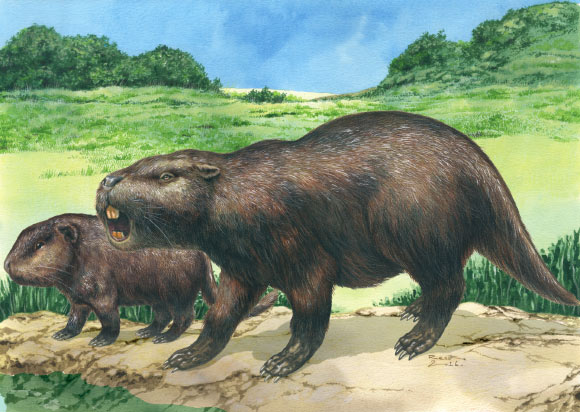Adult and juvenile fossil specimens of Isostylomys laurdillardi, a giant rodent that lived in South America between 9 and 6.8 million years ago (Miocene epoch), have been found by paleontologists, raising questions about classification within the rodent family Dinomyidae.
Dr. Andres Rinderknecht of the Museo Nacional de Historia Natural in Uruguay and his colleagues describe the new specimens in the Journal of Systematic Palaeontology, online on Feb. 22.
The fossils came from the Miocene Camacho Formation in the Río de la Plata coastal region of southern Uruguay.
“We describe fully grown adult and juvenile fossil specimens from the rodent family Dinomyidae, collected from the same location, lithostratigraphical formation and fossiliferous horizon,” the researchers said.
They examined the specimens and compared them with previously published fossils and with the largest living rodent, the capybara (Hydrochoerus hydrochaeris).
“The juvenile and the adult analyzed here represent some of the largest rodents known to science with some of these animals weighing almost a ton,” Dr. Rinderknecht and co-authors said.
“The adult remains consist of an almost complete skull with a partial jaw, while the juvenile’s remains are of a complete lower jaw and right heel.”
“Almost all previous discoveries of this kind have consisted of isolated teeth, and small fragments of skulls or jaws, which make this discovery some of the best-preserved remains of giant dinomids known to date.”
The results cast doubt on the validity of the subfamily Gyriabrinae, which may be composed of juveniles of different species within other subfamilies of Dinomyidae.
“We propose that members of the subfamily Gyriabrinae could represent juveniles belonging to other subfamilies of Dinomyidae, and that three known species of the genus Isostylomys should be merged into just one species, Isostylomys laurillardi,” the scientists said.
“Our study shows how the world’s largest fossil rodents grow and we describe fossil remains of a giant rodent baby and an adult,” Dr. Rinderknecht added.
_____
Andrés Rinderknecht et al. Making a giant rodent: cranial anatomy and ontogenetic development in the genus Isostylomys (Mammalia, Hystricognathi, Dinomyidae). Journal of Systematic Palaeontology, published online February 22, 2017; doi: 10.1080/14772019.2017.1285360








